Wacom Inkling Review
- You are here:
- Home
- Input Devices
If you're a creative professional that needs something to capture quick ideas on the go in a small and portable form factor, then the Wacom Inkling is for you. At $200 though, it isn't a solution for everyone.
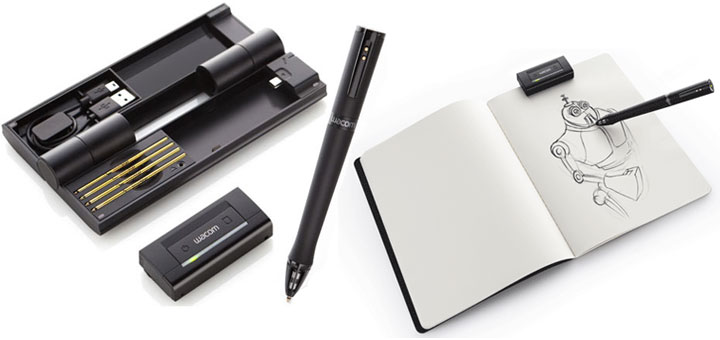
April 2012 Mikhail Kaplan
Wacom has been building tablets for creative professionals for decades. Their latest foray into sketching territory is the Inkling. Billed as a way to bring your sketches into the digital realm, Wacom intends on displacing the tried and true moleskin and pen for a small and discrete digital solution. Have their efforts worked or is the pen (or pencil) still mightier? Press on for the in-depth review of the Wacom Inkling to find out.
Build Quality
As always, Wacom has done a terrific job in the build, look, and feel of their product. The Inkling’s look seems to have been based on their already elegant-looking Intuos4 drawing tablets, a very glossy black on the matte black affair. Everything needed fits into a single 6.75″ x 2.5″ x 1″ black case and when I say everything, I mean everything. When you open the box that’s the only thing in it.
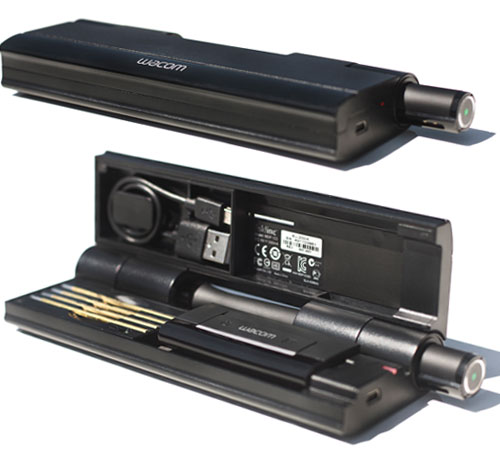
The case houses the pen and receiver as well as a USB cable and extra ink pen tips. Everything isn’t just strewn together either, you can tell that a lot of care was taken in designing the Inkling to be as portable as possible. As an example: rather than just make a spot for the pen to sit within the case, Wacom has engineered the pen to slide into the hinge and click-lock into place. Not only does this keep the pen safe and secure, it also charges it with two connectors inside the hinge. Brilliant! The portability doesn’t end with the physical case either. The receiver houses all the software needed to use it, both Mac and Windows, as well as a folder for your sketches. This means that as long as you’re near a computer, you can view all of your sketches. It truly is plug-and-play.
The case itself acts as a dock for everything. The Inkling’s receiver is plugged into it to charge and, as mentioned before, the pen is housed within the hinge. When you slide the pen out of the Inkling case, you’ll notice a certain heft to it, nothing overbearing and unusable but definitely heavier than I’m accustomed to drawing with. Holding the pen between my fingers it felt a bit too thick as well, but with very little cushion. The pen is comfortable in hand but after prolonged usage, my hand would get tired and cramp. The receiver is easy to use as well. It is only a clip with two buttons. The power button is on the left while the right button is used to create new layers.
Software
Just like the build quality, Wacom has made things straightforward (for the most part) and easy on the eyes. As mentioned previously, all the software needed is onboard the receiver, just plug the receiver in with any mini-USB cable and install the software. When you plug the receiver in after drawing, the Inkling software is automatically launched (at least on Windows). There you can only do a few things: look at your library of drawings, watch a sort of time-lapse of how you drew the sketch, or save/export the file out.
The library function is very straight-forward, you have a folder on the receiver of the Inkling labeled ‘My Sketches’. There you will find everything you ever drew, all in Wacom’s proprietary Inkling WPI file format. This is interesting because rather than use something universal such as a Tiff file that has the ability to be layered, they chose to make their own new file system so you have absolutely no way of circumventing their software. I can only assume this is to add the video capability, but more on that later.
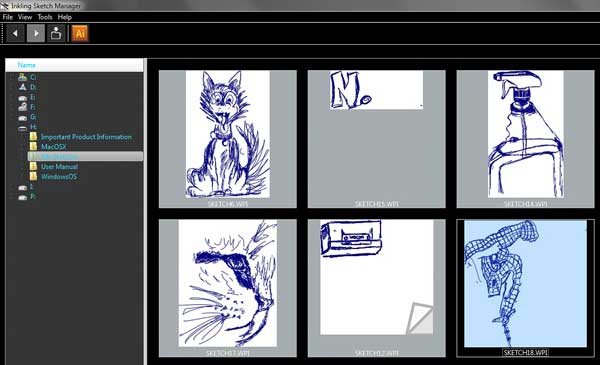
Next is the mildly frustrating time-lapse feature. Essentially this is a feature that allows you to view a video of the sketch being made stroke by stroke. The problem with this feature is that it’s too simple. You have the ability to speed and slow the drawing and zoom in and out. Beyond the obvious stop and play functionality, that’s it, that’s all. So what’s the point? You can’t natively save a video of your sketch to post anywhere or send to anyone. All you can do is watch it yourself or huddle some friends around your tiny monitor to watch the magic.
Finally the save and export features. These are quirky in the way they are implemented. Let me paint you a picture: say you make a sketch with three layers, it looks good, great even. You watched it over and over on the time-lapse player, it’s perfect. You want to save the layered file to send to your boss. You click ‘save as’ on your drawing and you’re taken to the saving screen. You now have options for file format but the only format that supports layered images is a Tiff, and guess what? You can’t save the TIFF with layers.
Fortunately, you have an option. You can export the proprietary Wacom file format to Adobe Illustrator, Adobe Photoshop, Autodesk Sketchbook pro, or Autodesk Sketchbook Designer. “Phew, that was close” you think to yourself. You go rifling through your applications on the 10-year-old Powerbook housing 250MB of RAM, running OS 10.4 (barely) that your company generously provided you. They didn’t install any of those programs. Well, you’re out of luck then. There is absolutely no way to save a layered document without circling through one of those four programs. If the receiver came packed with a supported program, then I would understand, but to limit functionality on the basis of user-end software is mind-boggling and frustrating. If you do have any of that software then it’s a breeze. It works as expected, click export and it places the desired layered vector file into the desired program and you can do with them as you wish.
Using Inkling
The main event! Sure, the software is slightly backward but it’s perfect for the creative type who sketches a lot, right? Well, sort of, but let me explain. As said in build quality, everything on the design and feels end are great, if not a bit awkward at first in the pen’s case. The problems start occurring on the actual using end, the part of the experience Wacom took 200 of your dollars for and you were very excited to try. The promise, it seems, is pin-point accuracy while sketching anything on any paper surface. The real-world experience, on the other hand, is a bit disappointing.
First of all, a small gripe of mine was that I was forced to use a pen. I understand there are some technical limitations at work here, but I am not used to drawing with pen so that took a little bit of time to get used to. When you are ready to start drawing, the receiver and pen must be turned on. There is no ‘On’ button on the pen so it relies on pressure at its tip to awaken. Without using the product you wouldn’t know this and my first few drawings started a few strokes after where I intended. The receiver on the other hand has an on button. Push that and clip it to some paper and you’re ready.
Something to also keep in mind while using the Inkling is that the pen needs a line of sight to the receiver as the two communicate using IR. The tip of the pen houses the portion that keeps it in contact. Blocking half an inch or so of the pen tip makes you lose your connection and the line isn’t recorded. Fortunately, the pen is sloped out at the end to keep your fingers out of harm’s way. All-in-all I had no connection issues while using it.

This artiste drawing in direct sunlight may be a bit misleading as infrared has an inherently hard time tracking in bright sun. This shot was intended strictly as a creative image and to show Inkling’s overall portability. I should also note that all tests conducted on the Inkling were done in a windowless office cubicle which I should add is quite poorly ventilated.
The draw to the Inkling is that you’re using pen on paper so sketching feels no different than normal all while digitizing your creation. When drawing though, it was important to pay attention to the receiver from time to time as it has a status light telling when the pen was in contact with the paper. The pen goes to sleep after a minute or so of inactivity, so you need to account for the lag of it returning from its slumber. The great thing about the pen is it uses standard mini ballpoint ink refills so changing them is a breeze. Pop the used one out of the pen and place a new one in. Plus the Inkling comes with four extra pen tips that are housed in the case.
When you’re on the go, the last thing you want to worry about is your precious digital pen running out of go-go juice. Wacom says that the Inkling has an eight-hour running time and during testing, there was never a single moment I ran out of power using it. I never really thought about charging it either. When I would get home for the day, I would plug the inkling into my computer to check the images. As I worked on my drawings, it would charge, and when I was done the Inkling would have enough life to last the next day. The really nice thing is that the Inkling only needs three hours to fully recharge the battery.
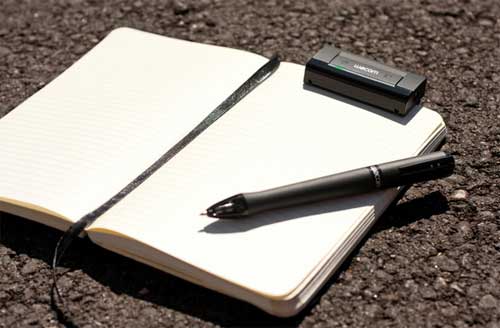
Wacom claims that the pen has 1024 points of pressure meaning that as you draw the pen tracks this pressure and thins or thickens the line. On a test where I drew straight lines of varying pressures, I could tell no discernible difference in thickness. This wasn’t a glaring flaw for me. Pen, as a medium, is either there or not there. You can’t quite achieve thicker lines the harder you press, just a ruined piece of paper as the pen tears through it.
After finishing your drawing, you’re anxious to see it. Trembling with excitement you plug in the receiver to your computer and pull the sketch into the sketch manager only to find a bit of a jumbled mess. This is Inkling’s biggest downfall. It’s largely accurate and will take the majority of your sketch correctly but 20% of your drawing will be either incorrectly tracked or just plain missing. The problem happens when you make fast gestures or very fine, precise ones. It either can’t track fast enough or the moving and angling of my hand were throwing it off. That’s a big disappointment, to be limited to drawing slowly and without small, precise mark-making. In the images below, you can see the inconsistencies with the lines on the suit, bow-tie, and hand. The speech bubble is cut off because the drawing was too close to the receiver.
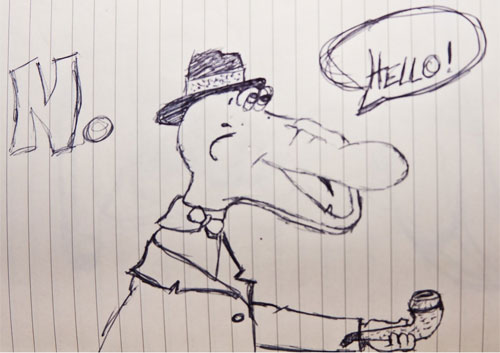
Image drawn on paper
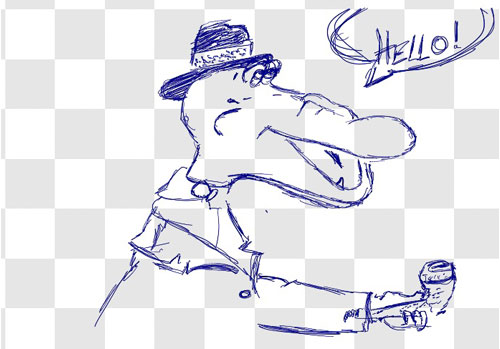
Digital interpretation by Wacom Inkling.
(Note: The “NO” doesn’t show up because it was a separate drawing. Sorry for the confusion.)
Recap
The Wacom Inkling is a great first shot by Wacom at a digital drawing solution. The build quality and engineering of every component is top-notch and its portability makes it a great companion on a day-to-day basis. While the software is a bit of a letdown, it is easy to use and works as expected. What really lowers the Inkling is its inability to track accurately and quickly, giving you a muddled interpretation of what is drawn. At $200 it is tough to recommend Inkling over the tried and true method of Sketch on paper, scan into Photoshop.
Nexcopy manufactures a variety of PC-based and standalone USB duplicator solutions.
PC based systems support advanced USB functions such as write protection, CD-ROM partition and multi-partition creation, while standalone systems are ultra-fast, high speed USB copiers duplicating gigabytes of data quickly and accurately.


I really love my Inkling. I disliked previous digital pens because the force need to use special paper, which was a serious limitation when drawing, writing or sketching anywhere. But the ability of Inkling to use any kind of paper is an outstanding advantage over other digital pens that sets Wacom a step forward its competitors. The behaviour of the tool is fine, it uses normal spare pen tips that you can find at any stationery shop.
The only drawback is the proprietary file format WPI, which forces you to use the Inkling Manager, but I found the way to make it portable and I carry it in the very USB storage included so it is a self contained solution for digital handwriting.
Really state-of-the-art technology.
Need to know if Wacom offers that complementary before buying it in my institute…..
Or does anyone know of any site which offers free trial of this set & decide then?
Great Product for Web designers and web artist . Great for Business use also.